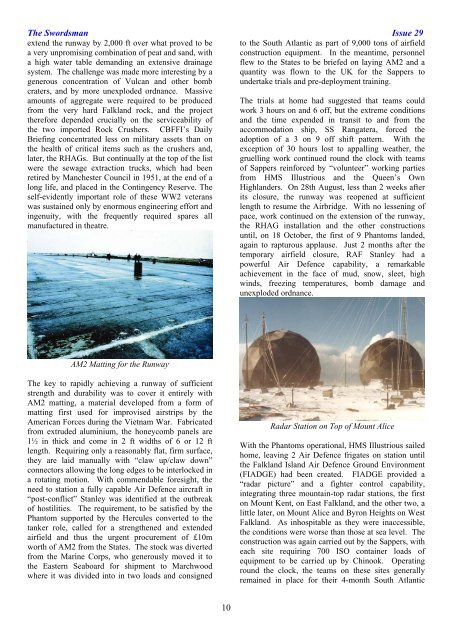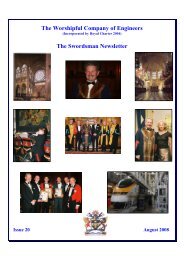The Worshipful Company of Engineers The Swordsman Newsletter ...
The Worshipful Company of Engineers The Swordsman Newsletter ...
The Worshipful Company of Engineers The Swordsman Newsletter ...
You also want an ePaper? Increase the reach of your titles
YUMPU automatically turns print PDFs into web optimized ePapers that Google loves.
<strong>The</strong> <strong>Swordsman</strong> Issue 29<br />
extend the runway by 2,000 ft over what proved to be<br />
a very unpromising combination <strong>of</strong> peat and sand, with<br />
a high water table demanding an extensive drainage<br />
system. <strong>The</strong> challenge was made more interesting by a<br />
generous concentration <strong>of</strong> Vulcan and other bomb<br />
craters, and by more unexploded ordnance. Massive<br />
amounts <strong>of</strong> aggregate were required to be produced<br />
from the very hard Falkland rock, and the project<br />
therefore depended crucially on the serviceability <strong>of</strong><br />
the two imported Rock Crushers. CBFFI’s Daily<br />
Briefing concentrated less on military assets than on<br />
the health <strong>of</strong> critical items such as the crushers and,<br />
later, the RHAGs. But continually at the top <strong>of</strong> the list<br />
were the sewage extraction trucks, which had been<br />
retired by Manchester Council in 1951, at the end <strong>of</strong> a<br />
long life, and placed in the Contingency Reserve. <strong>The</strong><br />
self-evidently important role <strong>of</strong> these WW2 veterans<br />
was sustained only by enormous engineering effort and<br />
ingenuity, with the frequently required spares all<br />
manufactured in theatre.<br />
AM2 Matting for the Runway<br />
<strong>The</strong> key to rapidly achieving a runway <strong>of</strong> sufficient<br />
strength and durability was to cover it entirely with<br />
AM2 matting, a material developed from a form <strong>of</strong><br />
matting first used for improvised airstrips by the<br />
American Forces during the Vietnam War. Fabricated<br />
from extruded aluminium, the honeycomb panels are<br />
1½ in thick and come in 2 ft widths <strong>of</strong> 6 or 12 ft<br />
length. Requiring only a reasonably flat, firm surface,<br />
they are laid manually with “claw up/claw down”<br />
connectors allowing the long edges to be interlocked in<br />
a rotating motion. With commendable foresight, the<br />
need to station a fully capable Air Defence aircraft in<br />
“post-conflict” Stanley was identified at the outbreak<br />
<strong>of</strong> hostilities. <strong>The</strong> requirement, to be satisfied by the<br />
Phantom supported by the Hercules converted to the<br />
tanker role, called for a strengthened and extended<br />
airfield and thus the urgent procurement <strong>of</strong> £10m<br />
worth <strong>of</strong> AM2 from the States. <strong>The</strong> stock was diverted<br />
from the Marine Corps, who generously moved it to<br />
the Eastern Seaboard for shipment to Marchwood<br />
where it was divided into in two loads and consigned<br />
10<br />
to the South Atlantic as part <strong>of</strong> 9,000 tons <strong>of</strong> airfield<br />
construction equipment. In the meantime, personnel<br />
flew to the States to be briefed on laying AM2 and a<br />
quantity was flown to the UK for the Sappers to<br />
undertake trials and pre-deployment training.<br />
<strong>The</strong> trials at home had suggested that teams could<br />
work 3 hours on and 6 <strong>of</strong>f, but the extreme conditions<br />
and the time expended in transit to and from the<br />
accommodation ship, SS Rangatera, forced the<br />
adoption <strong>of</strong> a 3 on 9 <strong>of</strong>f shift pattern. With the<br />
exception <strong>of</strong> 30 hours lost to appalling weather, the<br />
gruelling work continued round the clock with teams<br />
<strong>of</strong> Sappers reinforced by “volunteer” working parties<br />
from HMS Illustrious and the Queen’s Own<br />
Highlanders. On 28th August, less than 2 weeks after<br />
its closure, the runway was reopened at sufficient<br />
length to resume the Airbridge. With no lessening <strong>of</strong><br />
pace, work continued on the extension <strong>of</strong> the runway,<br />
the RHAG installation and the other constructions<br />
until, on 18 October, the first <strong>of</strong> 9 Phantoms landed,<br />
again to rapturous applause. Just 2 months after the<br />
temporary airfield closure, RAF Stanley had a<br />
powerful Air Defence capability, a remarkable<br />
achievement in the face <strong>of</strong> mud, snow, sleet, high<br />
winds, freezing temperatures, bomb damage and<br />
unexploded ordnance.<br />
Radar Station on Top <strong>of</strong> Mount Alice<br />
With the Phantoms operational, HMS Illustrious sailed<br />
home, leaving 2 Air Defence frigates on station until<br />
the Falkland Island Air Defence Ground Environment<br />
(FIADGE) had been created. FIADGE provided a<br />
“radar picture” and a fighter control capability,<br />
integrating three mountain-top radar stations, the first<br />
on Mount Kent, on East Falkland, and the other two, a<br />
little later, on Mount Alice and Byron Heights on West<br />
Falkland. As inhospitable as they were inaccessible,<br />
the conditions were worse than those at sea level. <strong>The</strong><br />
construction was again carried out by the Sappers, with<br />
each site requiring 700 ISO container loads <strong>of</strong><br />
equipment to be carried up by Chinook. Operating<br />
round the clock, the teams on these sites generally<br />
remained in place for their 4-month South Atlantic




